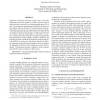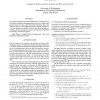112
Voted
ICASSP
2011
IEEE
14 years 4 months ago
2011
IEEE
Functional connectivity has been widely used to reveal the dependencies between signals in complex networks such as neural networks observed from electroencephalogram (EEG) data. ...
ICASSP
2011
IEEE
14 years 4 months ago
2011
IEEE
In order to extrapolate a signal, Empirical Mode Decomposition is used to decompose it into simpler components. Each component is individually extrapolated linearly, and the fina...
118
click to vote
ICASSP
2011
IEEE
14 years 4 months ago
2011
IEEE
In this paper an algorithm based on the ensemble empirical mode decomposition (EEMD) is presented. The key idea on the EEMD relies on averaging the modes obtained by EMD applied t...
97
Voted
ICASSP
2009
IEEE
14 years 10 months ago
2009
IEEE
An analysis of quaternion-valued intrinsic mode functions (IMFs) within three dimensional empirical mode decomposition is presented. This is achieved by using the delay vector var...
105
Voted
COST
2009
Springer
15 years 5 months ago
2009
Springer
Empirical mode decomposition (EMD) is an algorithm for signal analysis recently introduced by Huang. It is a completely datadriven non-linear method for the decomposition of a sign...
93
Voted
ITNG
2010
IEEE
15 years 5 months ago
2010
IEEE
This paper demonstrates the feasibility and potential of applying empirical mode decomposition (EMD) to forecast the arrival time behaviors in a parallel batch system. An analysis...
96
Voted
ICASSP
2008
IEEE
15 years 6 months ago
2008
IEEE
The empirical mode decomposition (EMD) has seen widespread use for analysis of nonlinear and nonstationary time-series. Despite some practical success, it lacks a firm theoretica...
108
click to vote
SCALESPACE
2009
Springer
15 years 6 months ago
2009
Springer
In this paper a framework for defining scale-spaces, based on the computational geometry concepts of α-shapes, is proposed. In this approach, objects (curves or surfaces) of incr...
93
Voted
ICASSP
2009
IEEE
15 years 7 months ago
2009
IEEE
For the first time, a proof of the sifting process (SP) and so the empirical mode decomposition (EMD), is given. For doing this, lower and upper envelopes are modeled in a more c...
79
Voted
ICPR
2008
IEEE
16 years 1 months ago
2008
IEEE
Here, a versatile data-driven application independent method to extend the depth of field is presented. The principal contribution in this effort is the use of features extracted ...


